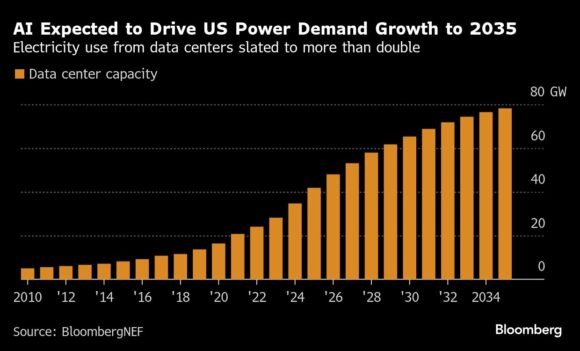US Warns of Blackout Risk From Killing Coal as Trump Snubs Renewables
July 7, 2025
Blackouts in the US could double by 2030 amid an expected increase in power demand brought on by AI, according to a Trump administration report seen as a precursor to a broader intervention to help keep coal-fired power plants from closing early.
The Energy Department report blames the expected shortfall on the closures of coal and natural gas power plants and the overreliance on renewable energy. The analysis, which comes in response to an executive order from the White House on strengthening grid reliability and security, provides a methodology to identify areas vulnerable to outages to allow for “Federal reliability interventions.”
A 100% “surge in power outages” is expected within five years if planned power plant closures remain on schedule without new units to replace them, the Energy Department said in ahead of the report. “Staying on the present course would undermine U.S. economic growth, national security, and leadership in emerging technologies,” it said.
The report backs President Donald Trump’s pro-coal and anti-renewable approach to energy generation, painting wind and solar as unreliable and part of a “radical green agenda of past administrations.” It also comes as the Energy Department has been using emergency authority to extend the life of coal and other plants, citing concerns about shortages of electricity as data centers, which power artificial intelligence models, require more supply.
“If we are going to keep the lights on, win the AI race, and keep electricity prices from skyrocketing, the United States must unleash American energy,” Energy Secretary Chris Wright said in a statement.
The department noted the analysis could inform use of the emergency authority in the Federal Power Act to order coal and natural gas plants to keep operating, which the administration has already used to save two plants that were slated to retire. Trump administration officials considered using similar authority during the president’s first term to help struggling coal plants from shutting down, but ultimately decided against the effort.
The report also comes on the heels of Trump’s $3.4 trillion fiscal package, which marked a deep setback to the US shift to clean energy by phasing out tax credits wind turbines and solar panels. Renewables were positioned to be leading providers of energy supply in coming years, with utility-scale solar last year accounting for 61% of US capacity additions, or 30 gigawatts, according to the Energy Information Administration.
Solar was primed for further growth because it’s the cheapest domestic electric source, batteries capable of deploying excess power in the evening have become mainstream, and it’s quicker to build than natural gas-fired plants or atomic reactors.
“The study released today by the Department of Energy appears to exaggerate the risk of blackouts and undervalue the contributions of entire resource classes, like wind, solar, and battery storage, despite the fact that regions like Texas that have enabled rapid growth of these technologies have been rewarded with lower costs and a more reliable grid,” said Caitlin Marquis, managing director at Advanced Energy United, which represents companies such as renewable developers such as The AES Corp. and Clearway Energy Inc.
According to the Energy Department, the rough equivalent of 100 nuclear reactors are set to retire by 2030 which could lead “to significant outages when weather conditions do not accommodate wind and solar generation.”
Photo: An earth mover pushes coal into piles at the PacifiCorp Hunter coal-fired electrical generation plant in Castle Dale, Utah. Photographer: George Frey/Bloomberg
Topics
USA
Was this article valuable?
Thank you! Please tell us what we can do to improve this article.
Thank you! % of people found this article valuable. Please tell us what you liked about it.
Here are more articles you may enjoy.
Search
RECENT PRESS RELEASES
Related Post



